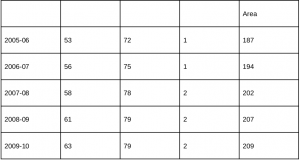2013 June UGC NET Paper 1
Question 1 |
Choose the proper alternative given in the codes to replace the question mark
Bee-Honey, Cow-Milk, Teacher-?
Bee-Honey, Cow-Milk, Teacher-?
Intelligence | |
Marks | |
Lessons | |
Wisdom |
Question 2 |
P is the father of R and S is the son of Q and T is the brother of P. If R is the sister of S, how is Q related to T
Wife | |
Sister-in-law | |
Brother-in-law | |
Daughter-in-law |
Question 3 |
A definition put forward to resolve a dispute by influencing attitudes or stirring emotions is called
Lexical | |
Persuasive | |
Stipulative | |
Precisions |
Question 3 Explanation:
Persuasive: Good at persuading someone to do (or) believe something through reasoning (or) the use of temptation.
Question 4 |
Which of the codes given below contains only the correct statements?
Statements:
(i) Venn diagram is a clear method of notation.
(ii) Venn diagram is the most direct method of testing the validity of categorical syllogisms.
(iii) In Venn diagram method the premises and the conclusion of a categorical syllogism is diagrammed.
(iv) In Venn diagram method the three overlapping circles are drawn for testing a categorical syllogism.
Statements:
(i) Venn diagram is a clear method of notation.
(ii) Venn diagram is the most direct method of testing the validity of categorical syllogisms.
(iii) In Venn diagram method the premises and the conclusion of a categorical syllogism is diagrammed.
(iv) In Venn diagram method the three overlapping circles are drawn for testing a categorical syllogism.
(i), (ii) & (iii) | |
(i), (ii) & (iv) | |
(ii), (iii) & (iv) | |
(i), (iii) & (iv) |
Question 4 Explanation:
Statements (i), (ii) & (iv) are true.
Question 5 |
Inductive reasoning presupposes
Unity in human nature. | |
Integrity in human nature. | |
Uniformity in human nature. | |
Harmony in human nature. |
Question 5 Explanation:
Inductive reasoning presupposes the uniformity in human nature.
Question 6 |
Read the table below and based on this table answer questions from 6 to 11:
Area under Major Horticulture Crops (in lakh hectares)


Which of the following two years have recorded the highest rate of increase in area under the total horticulture?
Area under Major Horticulture Crops (in lakh hectares)

Which of the following two years have recorded the highest rate of increase in area under the total horticulture?
2005-06 & 2006-07 | |
2006-07 & 2008-09 | |
2007-08 & 2008-09 | |
2006-07 & 2007-08 |
Question 7 |
Read the table below and based on this table answer questions from 6 to 11:
Area under Major Horticulture Crops (in lakh hectares)


Shares of the area under flowers, vegetables and fruits in the area under total horticulture are respectively:
Area under Major Horticulture Crops (in lakh hectares)

Shares of the area under flowers, vegetables and fruits in the area under total horticulture are respectively:
1, 38 and 30 percent | |
30, 38 and 1 perctent | |
38, 30 and 1 percent | |
35, 36 and 2 percent |
Question 8 |
Read the table below and based on this table answer questions from 6 to 11:
Area under Major Horticulture Crops (in lakh hectares)


Which of the following has recorded the highest rate of increase in area during 2005-06 to 2009-10?
Area under Major Horticulture Crops (in lakh hectares)

Which of the following has recorded the highest rate of increase in area during 2005-06 to 2009-10?
Fruits | |
Vegetables | |
Flowers | |
Total horticulture |
Question 9 |
Read the table below and based on this table answer questions from 6 to 11:
Area under Major Horticulture Crops (in lakh hectares)


Find out the horticultural crops that have recorded an increase of area by around 10 percent from 2005-06 to 2009-10.
Area under Major Horticulture Crops (in lakh hectares)

Find out the horticultural crops that have recorded an increase of area by around 10 percent from 2005-06 to 2009-10.
Fruits | |
Vegetables | |
Flower | |
Total horticulture |
Question 10 |
Read the table below and based on this table answer questions from 6 to 11:
Area under Major Horticulture Crops (in lakh hectares)


What has been the share of area under fruits, vegetables and flowers in the area under total horticulture in 2007-08?
Area under Major Horticulture Crops (in lakh hectares)

What has been the share of area under fruits, vegetables and flowers in the area under total horticulture in 2007-08?
53 percent | |
68 percent | |
79 percent | |
100 percent |
Question 11 |
Read the table below and based on this table answer questions from 6 to 11:
Area under Major Horticulture Crops (in lakh hectares)


In which year, area under fruits has recorded the highest rate of increase?
Area under Major Horticulture Crops (in lakh hectares)

In which year, area under fruits has recorded the highest rate of increase?
2006-07 | |
2007-08 | |
2008-09 | |
2009-10 |
Question 12 |
‘www’ stands for
work with web | |
word wide web | |
world wide web | |
worth while web |
Question 13 |
A hard disk is divided into tracks which is further subdivided into
Clusters | |
Sectors | |
Vectors | |
Heads |
Question 14 |
A computer program that translates a program statement by statement into machine languages is called a/an
Compiler | |
Simulator | |
Translator | |
Interpreter |
Question 15 |
A Gigabyte is equal to
1024 Megabytes | |
1024 Kilobytes | |
1024 Terabytes | |
1024 Bytes |
There are 15 questions to complete.
